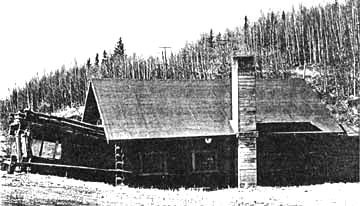
Coping with the Permafrost Foundation
Permafrost has been defined as frozen ground in which a naturally occurring temperature below 0o Centigrade (32o Fahrenheit) has existed for two or more years. That's a deceptively simple description of a very complex engineering problem in the north.
Permafrost is continuous in extent over almost all of the Arctic, then becomes discontinuous and sporadic or isolated as one proceeds further south. Only the southern coastal margins are completely permafrost-free. Measured recorded depths extend from 1330 feet near Pt. Barrow to 350 feet at Nome, 265 feet at Fairbanks, and 100 feet near Tok. It is near- surface permafrost that is the bane of the construction worker and home builder, however. Permafrost can form an extremely strong and stable foundation material if it is kept in the frozen state, but if it is allowed to thaw, the soil becomes extremely weak and foundations built on it are almost guaranteed to fail.
There are three approaches to dealing with the permafrost problem in the construction practice. The first and most obvious is to avoid it entirely. The second is to destroy it by stripping the insulating vegetative cover and allowing it to melt over a period of years. This has the obvious drawback of requiring a considerable period of time to elapse before construction can begin, and even then, it is a good idea to excavate the thawed ground and replace it with coarse material.
The third approach, and one which is becoming more widespread, is to preserve it. This can be accomplished by building on piles to allow cold air to circulate beneath heated structures, by building up the construction site with gravel fill which insulates and protects the permafrost below, or by refrigeration to maintain low ground temperatures. This is done by utilizing thermal piles or freeze tubes, such as those used by the trans-Alaska pipeline. These devices are filled with a non-freezing liquid and act like coffee percolators. They are cooled during the winter months and draw heat from the ground to retard thawing during warm weather.
In deciding if precautionary measures should be taken, it is first necessary to determine whether or not the building site actually has a permafrost problem. A lot can be learned just by looking over the land. If one stands on a ridgetop in interior Alaska and faces north, a typical sequence of vegetation extending into the distance usually includes black spruce of low productivity extending down the north slope of the ridge and into the lowlands of the neighboring valley. These are usually permafrost-rich sites which merit special construction practices. On the south slope of the facing ridge can generally be seen lighter vegetation signaling birch and aspen, interspersed with darker green areas indicative of white spruce. These characterize permafrost-free soils and more desirable building conditions.
But what if one is uncertain as to the actual nature of the foundation material? There are several methods of determining if permafrost is present. The simplest of these is called "rodding." A 1/4 to 1/2-inch sharpened steel rod is driven with a heavy hammer until it will go no further. The rod is then turned with a pair of vice-grip pliers. If it turns easily, it has probably hit a stone, but if it twists and then springs back to its original alignment, it has penetrated either wood or permafrost. The sound given off by the rod when struck can usually determine which of these it is. A sharp clang indicates a stone, a dull clang indicates ice, and a dead thud usually means wood.
A hand auger can usually provide information that the rod cannot. With a standard soil auger, penetration of ice in permafrost is extremely difficult and the usual sign when it has been reached is that the auger does not bite into the soil, but merely scrapes up frozen bits. Dropping the auger into the hole produces a dull thunk on permafrost and a sharper clank when striking a stone.
Digging a pit is a method requiring more labor, but it is a more positive method of determining the depth and character of the soil and permafrost, if it exists.
Core drilling by machine gives a continuous log of the material through which the bit passes, and is the most positive method of obtaining a record of the foundation material. Although it is more expensive than the other means, the cost of boring is minor compared with the cost of repairing building foundations which may settle if proper precautions are not taken.





